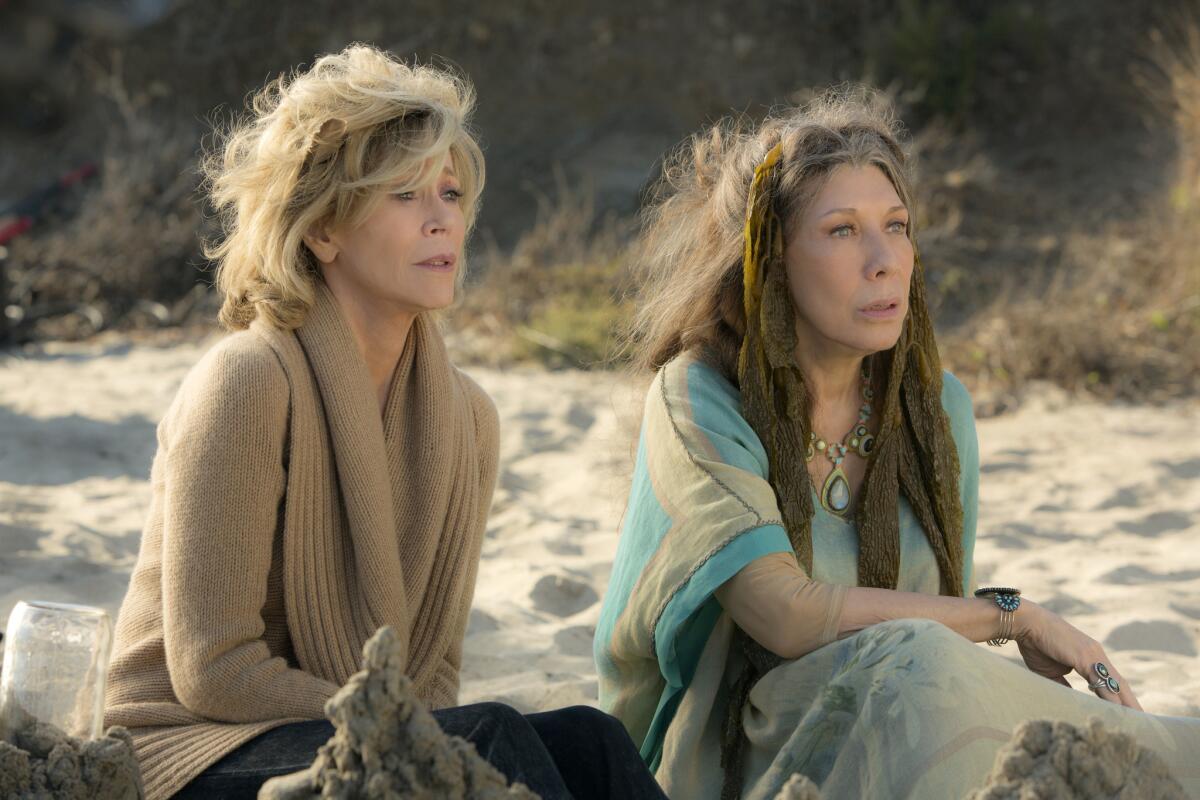Review: Fonda, Tomlin lend maturity to Netflix comedy âGrace and Frankieâ

Jane Fonda, left, and Lily Tomlin in the Netflix Original Series âGrace and Frankie.â
Thirty-five years after Jane Fonda recruited Lily Tomlin as a co-star in âNine to Five,â the two have teamed together again, this time for a TV series, âGrace and Frankie.â Created by Marta Kauffman, who co-created âFriends,â and Howard J. Morris, who wrote for âHome Improvement,â it premieres Friday on Netflix (the self-described âworldâs leading Internet television networkâ).
Fonda plays Grace; Tomlin is Frankie. We meet them meeting at a fancy restaurant, and it is made clear from the get-go that all they have in common are their husbands, business partners Robert (Martin Sheen) and Sol (Sam Waterston), who arrive presently to announce that they are in love with one another and want to get married because, says Graceâs Robert, âyou can do that now.â And weâre off.
(The series is a reunion in more ways than one: Tomlin spent time on âThe West Wingâ with Sheen, as Fonda did with Waterston on âThe Newsroomâ â both Aaron Sorkin series, interestingly.)
In that it deals with a late-life announcement about sexual identity, âGrace and Frankieâ has a superficial kinship to another recent Internet series, Jill Solowayâs âTransparentâ on Amazon. But the husbandsâ story line, while certainly tended to and nicely played, is not really the point â itâs the device, rather, that launches the women into close mutual orbit, that gives them a reason to commiserate and collaborate despite their heavily limned antipathies and differences.
Grace, who founded a makeup line, is put together from the outside in: She lives in a state of glacial perfection; in more ways than one, including her marriage, sheâs invested in appearances. Frankie, an amateur painter who teaches art to ex-cons, is squishy and spiritual and all over the place. But they wind up living together, more or less, in a co-owned beach house. That is to say, a mansion on the water: We are, again, in the company of the well-heeled.
More fundamentally, it resembles the kind of mature, upscale romantic comedies that Diane Keaton (and Keaton almost alone among American actresses) makes nowadays â the sort of film described in a recent Amy Schumer sketch on the sexual bankability of older actresses as having âvery vague yet uplifting titles like âWhatever It Takesâ or âShe Means Well.ââ And itâs also a kind of female version of the antagonistic buddy films Jack Lemmon and Walter Matthau made together toward the end of their careers â âGrumpy Old Women,â if you will.
Itâs a (mostly) polite entertainment that bad language and a peyote trip make no less (mostly) polite. Some of it feels stagy. A few too many gags advertise their subjects: Here is a joke about hearing loss, here is a joke about bad vision, about the invisibility of the aged, about sex after 70. Here is a joke about old people and technology. (Frankie slamming a smartphone down on a table as if it were an old-fashioned receiver is a good one.)
Still, they wear their age more or less proudly â we are told that Grace is 70 (Fonda is actually a supple 77), though her daughter advises to call herself 64 for online dating, and Frankie needles her cryptically about plastic surgery. (All four principals are in their 70s, which does feel a little revolutionary.)
The leads each fare better when her character is a little off base â Fondaâs when she defrosts a little, Tomlinâs when she toughens up â and the show is more fun when theyâre in a mood to cooperate than when theyâre trading barbs. Though they have their own special quirks and burdens, their children â Brooklyn Decker and June Diane Raphael play Graceâs, Ethan Embry and Baron Vaughn are Frankieâs â are largely there for the stars to bounce off. (Raphael, the wiseacre among them, and the deliverer of some of the seriesâ more striking lines, does stand out, especially in some later scenes with Tomlin.)
Still, more often than not, I found myself caring more about the actresses than the characters they played â finding their show a little wan but wanting it to work, both out of a lifetime of respect and because there could stand to be more series in which the main characters are not designed to appeal to TVâs hallowed 18-34 demographic. (This is Netflix; their metrics may vary.) The series does get better as it goes on â six of 13 episodes were made available to review â and grows less concerned with telling you who these people are and more interested in watching them.
Twitter: @LATimesTVLloyd
------------
âGrace and Frankieâ
Where: Netflix
When: Anytime, starting Friday
Rating: TV-MA (may be unsuitable for children under the age of 17)
More to Read
The complete guide to home viewing
Get Screen Gab for everything about the TV shows and streaming movies everyoneâs talking about.
You may occasionally receive promotional content from the Los Angeles Times.







